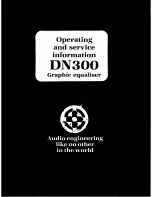
DETAILED
PARAMETERS
37
260
USER
GUIDE
Bypass
When "Bypass" is "on", the box behind it is highlighted in green; when the
box is in white, it means that "Bypass" is off. When "Bypass" is "on", the
Limiter is turned off; when "Bypass" is "off", the Limiter is turned on.
Attack 10dB / S to 500 dB / S (per band or global)
This is the speed at which the 260 limiter starts to compress the signal
once it has crossed the threshold. Set the attack time longer for lower
frequency bands, and shorter for higher frequency bands.
Release 360dB / S to 5 dB / S (per band or global)
Just like the release time on the compressor, the limiter's release time
controls how fast the limiter releases from gain reduction after the signal
drops below the threshold. Set the release times longer for lower
frequency bands and shorter for higher frequency bands.
Hold 0 to 500 m Sec (per band or global)
Hold is the time the limiter stays in gain reduction after the signal level
has dropped below threshold. Hold is useful when you want the limiter to
function for a period of time after it has been triggered. Be careful not to
set the hold time too long as it will not release in time.
Soft Knee Off to 10
There are ten levels of Soft Knee that can be used for the limiters. The
point when the compressor starts to compress is the "knee". When the
compressor starts to reduce the level of a signal abruptly as it passes
over the threshold this is called "hard knee" compression. Soft Knee is
when the volume of the sound is compressed gradually. Soft Knee
compression starts to compress before the level of the signal reaches the
threshold and reaches full compression after the level has gone above
the threshold. This Soft Knee compression, by its very nature sounds
much smoother and more natural and will be used for most applications.







































